|
Avro Lancaster B.III (Special) The Dambusters

Airfix, 1/72 scale
S u m m a r y : |
Catalogue Number: |
A09007 Avro Lancaster B.III (Special) The Dambusters |
Scale: |
1/72 |
Contents & Media |
Six grey and one clear sprues, well over a hundred parts, with decals for two machines. |
Price: |
Available worldwide including online from these stockists:
|
Review Type: |
First Look. |
Advantages: |
The best of the three modern Lancaster kits, accurately shaped, good interior detail, promise of several variants, and good value. |
Disadvantages: |
Nothing serious - No parts map and minor errors and omissions in instructions; fuselage side windows too small and no chamfer on elevator outer edge (both easily fixed); exaggerated fabric effect on ailerons and decaled rather than 3-D instrument panels. |
Conclusions: |
This is a sterling effort from Airfix.
I consider this to be the best Lancaster kit so far released, with the promise of several versions including a long-awaited Mk.II.
Airfix has captured some key shapes better than their competitors, they have supplied plenty of nice interior detail, some of the best of which will hardly be seen in the wheel wells. Some parts are very finely moulded, and I like the plastic Airfix uses as it is nice to work with. The transparencies are very well done with delicate framing and very good clarity. The provision of a bomb-trolley for the Upkeep mine is a nice touch.
The kit has some way to go to approach perfection however. Airfix’s surfaces detail is acceptable; in part because the kit’s good points offset it. Looked at critically however, Airfix need to improve the finesse of their recessed panel detail to at least equal that which most other modern long-run brands have been offering for the past thirty years or more. I have a few niggles; oversized fuselage windows, no chamfer on elevator outer edge (both easily fixed), exaggerated fabric effect on ailerons, decaled rather than 3-D instrument panels, no parts map, and some proofing errors in the instructions.
As to its competitors from Revell and Hasegawa – You can save around 25-30% on Airfix and buy the less accurately shaped kit from Revell. The price of replacement resin wheels, which really are a must with the Revell kit, will reduce its price advantage however. For around 60-80% more than Airfix you can buy Hasegawa’s kit which offers only more refined panel lines and better props, but falls short on interior detail, no lowered flaps option, and inferior shape in a few subtle places.
For my money then, Airfix is clear winner, and deservedly so.
I recommended this kit highly.. |
Reviewed by Mark Davies

Airfix's 1/72 scale Dambusters Lancaster is available online from Squadron.com
The Lancaster’s development and operational history must be one of the best known amongst aircraft modellers and enthusiasts. With this in mind I shall not provide an account here. For those who want to know more the Internet is replete with information on this famous WW2 bomber and the famous Dams Raid, not to mention numerous publications and video documentaries.
Review Approach
In considering how best to approach this review I realised that there are probably three main areas of interest for Hyperscalers where this kit is concerned. Primarily, how does it measure up as a Lancaster per se, rather than specifically as a dambuster, and therefore how does it compare with its competitors. Then what other versions do the kit contents suggest will follow (although some have been announced already), and perhaps finally, how well does it cater for the dambuster version.
I have used some cropped images to illustrate some of my points regarding airframe shape. These are from images I have downloaded over the years, and as far as I am aware have no copyright claimed. I am unable to attribute them to anyone, but if a reader considers that I have used their image(s) and would like it attributed to them, or deleted from the article, then please e-mail me.
Previous 1/72 Scale Lancaster Kits
In six or so decades of plastic modelling the Lancaster has not been as well catered for as it historic importance would suggest it should have been, even in the One True Scale of 1/72nd. Airfix’s first effort dates from 1958, followed by Revell in 1964. Both have serious accuracy and outline issues, and they are a best considered as collectables now. Revell was unusual in that it offered a Dambuster boxing as well. Frog was next in 1976 with a Tallboy carrying variant with bulged bomb-bay doors. It was generally fairly accurate, but failed to capture the engine cowling outlines correctly. It did however have perhaps the finest and most restrained surface detail of the 20th century Lancaster kits. Matchbox issued their kit in 1977, and despite being optimised for the younger modeller was generally well thought of, and was more accurate than the Frog kit. All of these pre-1980 releases were typical products of their time with the usual characteristics of their brands.
In 1981 Airfix released a new tool kit smothered with raised rivet and panel line detail, albeit very restrained. Its outline shape and dimensional accuracy were well received, with only a few minor quibbles such as slight excess span (easily fixed by correcting the curvature of the wing tips), and the bomb aimer’s blister was the shorter early type, and so not suited to the B Mk.III. It is fairly basic kit from the standpoint of cockpit, gun turret, wheel well and bomb bay detail. Fit is not always the best, which makes keeping the raised surface detail a real a challenge once joints were cleaned up. Airfix released various B.1 special boxings, including a dambuster issue in 1993. Accuracy-wise it is still well regarded.
Hasegawa released the first modern engraved detail kit of the Lancaster in 2005. This is a nice kit, and is typical of the brand with clean crisp moulding, and fine surface detail. However, it suffers from indifferent engine radiators and incorrect escape hatch and oversized tail wheel, and fit of the engine nacelles is not as good as it might be. Interior detail is basic, and the number of panel lines excessive, as every rivet line is represented by an engraved line, as opposed to sheet of metal forming a panel. This makes the wing surfaces look like a patchwork quilt. True to form, Hasegawa has released numerous boxings, including Tallboy and Grand Slam boxings, a life-boat carrier, and a dambuster variant.
Revell were not far behind Hasegawa with a well priced modern kit featuring quite a bit more detail. Unfortunately, as with their later Halifax kit, Revell was asleep at the wheel during some stages of the kit’s development. Most notably they forgot to crank in enough wing dihedral, and churned out some very bland and oversized main wheels. Fortunately both problems are easy enough to fix. Like Hasegawa, Revell got carried away with fine engraved panel lines, again especially on the wings. Revell too have offered a dambuster version of the kit. Fortunately, Revell’s price is such that these wing and wheel issues can be fixed whilst still have some change left over compared to the Hasegawa alternative.
As an aside, I often think finished models using the 1981 Airfix kit with its raised surface detail, either retained or sanded off, look more realistic than models using the Hasegawa or Revell kits with their extensive engraved panel lines. However, the more modern kits are clearly easier to build and weather, thanks in a large part to their recessed surface detail.
There have been no mainstream kits of the Lancaster Mk.II with its radial engines, nor of some of the later Lancaster versions. These, and models of Lancastrians, Manchesters, Lincolns and Yorks have remained in the realm of conversions or all-resin kits. Although outside this review’s scope, there is still only one 1/48-scale Lancaster by Tamiya (also with a dambuster boxing), which is also long in the tooth.
Other Variants
Airfix’s release of its new tool Lancaster Dambuster is clearly linked to the 70th anniversary of the Dams Raid this year. No doubt they calculated an advantage in releasing the dambuster kit ahead of the standard B Mk.I/III, as those impatient for a standard bomber would buy the dambuster version regardless of any price premium price the dambuster may demand.
Airfix has already announced that it will be offering a B Mk.1/III and a most welcome B Mk.II, the radial-engined option being a first for a mainstream 1/72nd kit. The kit also features parts for the late FN.82 rear turret with twin .50-cal machine guns (but no Rose turret option), narrow and paddle-blade propellers, shrouded and exposed exhausts, early and later style bomb-aimer’s blister, optional observation blisters in the sides of the main canopy, and optional H2S dome; so more releases are sure to follow including late and post-war versions no doubt. Well done Airfix!
Contents
The kit comes in a top-opening box with attractive artwork. The sprues are enclosed in a single heat-sealed plastic bag, with the clear parts further protected in their own smaller bag.
The decals and instructions come loose in the box. The multi-lingual instructions do not have a parts map, which given the large number of optional parts would have been useful. Surely, providing a parts map is not a great ask, nor particularly expensive in these days of CAD. The well-drawn diagrams appear easy to follow, but I have read some build logs on-line that indicate a few problems with instructions involving part-numbering errors, and failure to identify some small steps like opening a mounting hole for the forward altimeter spotlight. The painting and markings guide is well done in colour with four views for each markings option.
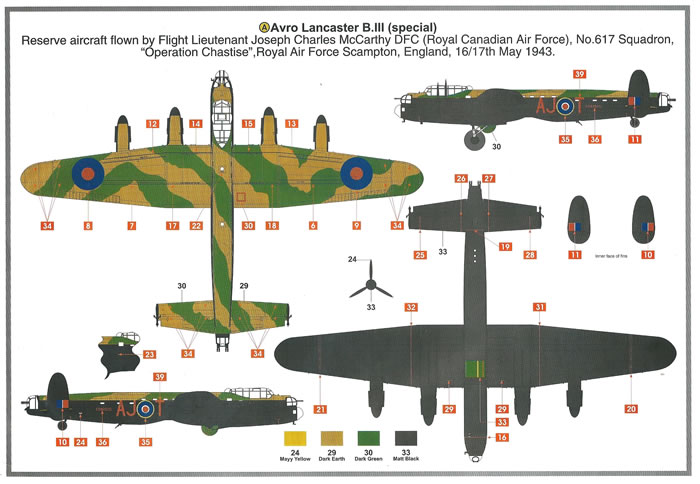
Colours are described using generic or RAF names where applicable, with paint codes that correspond to the Humbrol range, although this does not appear to be stated anywhere. The main parts are on six light grey sprues with a single clear sprue. One of the grey sprues is dedicated to the Dambuster version. I expect that in the B.1/III boxing that this sprue is replaced by one with a more conventional payload.
The Kit
The parts are moulded in a slightly soft plastic that has a nice feel to it. There is some evidence of fine flash in places like the propeller blades, which is not so good. It has reasonably fine recessed panel lines, although not as good as Hasegawa’s or Revell’s.
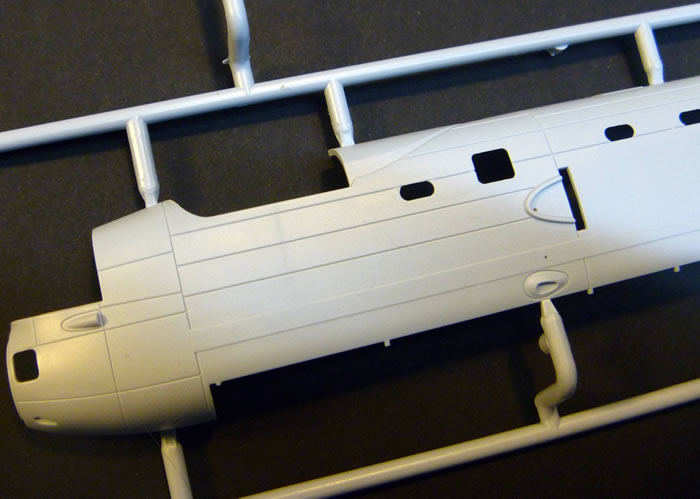
Pleasingly, the wing panel lines are based on panel skins and not rivet lines, so the wings do not share the patchwork quilt appearance of its Japanese and German competitors. This advantage balances out some of the downside to having deeper and wider surface detail compared to the Hasegawa and Revel kits. I did notice that the panel lines on the wings look wider at first glance than they actually are. This is because the plastic surface has a minutely pebbled finish*, other than a very narrow smooth surface finish either side of the recessed panel lines. These smooth strips either side of the panel line stand out against the pebbled surface making the unpainted line appear wider.
*Common with many kits, as it eases the release of parts by reducing mould suction associated with a perfectly smooth finish.
The sprue gates are reasonably fine and far better than Airfix’s new tool Typhoon I recently reviewed. There are some quite fine parts; and these are some of the best I have seen in a new tool Airfix kit, conceding little if anything in refinement compared to other brands like Hasegawa. The clear canopy parts are thin with good clarity. Airfix’s tool makers have managed to leave a few prominent ejector pin marks that will need cleaning up, as will sink marks in a few areas. The bomb doors on my sample were a little warped, but should straighten out with some hot water treatment.
The kit is engineered in a slightly unusual way compared to most Lancaster kits because the wings must accept both in-line and radial engine options. Theses differ in the way the nacelles blend with the wing, and so Airfix has cutouts in the wing leading edges to allow for this. The other unusual aspect is the way the two wing spars, having been inserted through the fuselage, then have the wheel well interiors attached directly to them. This then requires that the wings be assembled around the wheel wells and onto the spars. All well and good, except that one of the benefits of building WW2 British heavies is that you can usually assemble the wings separately from the fuselage to aid dealing with seams and enable the wings and fuselage to be painted and decaled separately from each other. All is not lost however, as you can assemble the spars and wheel well structure as per the instructions, then simply cut through the spars adjacent to the wheel well to enable these to be assembled with the wings separately. More than enough spar will be left to slide the wings onto later after painting. The rearmost part of the fuselage adjacent to the elevators is catered for by an insert to allow for slight variances depending on the model of tail-turret fitted.
Having covered the more unusual aspects of this kit, normal service will now resume with a look at the cockpit. Airfix provide a reasonably fine and realistic interior. There is of course a cockpit floor formed by the forward section of the bomb-bay, with the raised pilot’s area as a separate part, and a quite nicely done pilot’s seat (no harness detail though). The navigator has his table, complete with a decaled map, partial bulkhead, chair and a device that mounts on the end of the table. I think this item may be associated with H2S equipped aircraft, and if so, should be left off a dambuster model. There is a flight-engineer’s folding seat and instrument panel represented by a decal, as is the pilot’s panel. The decals in both cases are coloured, but still use white outlines for the instrument bezels. This might have been okay in 1981 with Airfix’s second Lancaster tooling (the 1958 version used a paper cut-out from the instructions), but over 30 years on I would like to see well detailed moulded instruments on the panels, with the decals as an option. The Pilot’s instrument panel includes a throttle box and there are rudder pedals to attach to it as well. The cockpit side walls, including in the bomb-aimer’s area, have integrally moulded detail. There is also a conventional bomb-sight that the instructions fail to tell the builder to leave out, as this was not used in the Dams Raid. Overall, the cockpit as supplied will look quite adequate with a seat harness or two added.
There are a number of small fuselage windows to add; which some later Lancasters had blanked off. I am quite sure that Airfix has made theirs too deep compared to photos of the real thing, and are also after comparison with the Hasegawa and Revell kits. This is a minor problem however. Small clear inserts rarely fit perfectly due to their angled sides that are needed to release them from the mould, and so frequently require filling around their circumference. Once filled and sanded to fully blend in with the fuselage, the windows can be polished up and simply have a suitably shallower area masked off to ensure that they appear the right size after painting.
The two wing spars must be added to the bomb-bay floor before closing the fuselage halves. The bomb-bay interior is nicely detailed, and includes the sidewalls in this area, as well as finely moulded bomb crutches not used with this version. The instructions direct that holes be opened up in the floor as these are associated with the dambuster option. There is also the choice of a blanking pate or Vickers K “scare-gun” to fit where the FN 64 ventral turret would otherwise mount (no doubt supplied with the Mk II sprues). The instructions guide which of the two decal options the gun applies to, but check your references if you are modelling other 617 Sqn aircraft. Airfix supply a clear transparency to insert in the rear fuselage’s underside to represent the three signalling lights. I have read one on-line build log that the bomb-bay bulkheads need some gentle trimming if the fuselage halves are to close neatly.
The wings include nicely detailed flaps that can be modelled raised or lowered, with two different inboard nacelle end-caps to suit raised or lowered flaps. In fact, on the real plane, the full size end-cap fitted to the flap partially disappears inside the open end of the engine nacelle, but the way the kit simulates this at least serves to set the flap angle. Slightly less pleasing is the slightly sagged fabric effect on the ailerons; why some tool makers insist on representing fabric covered control surfaces this way I do not know. Take a look at a real example and they would see that the fabric is drum-tight with rib-tapes indicating the location of the structure beneath. In 1/72-scale there should be at most just a hint of the tape reinforcement outlining the structure beneath. Airfix’s ailerons really need to filled and smoothed out, with perhaps decal strip rib-tapes, to appear more authentic. On the plus side, as I have already mentioned, Airfix’s recessed panel lines are restricted to representing panel skins rather than occurring on every rivet line. So, despite being perhaps a little deep, they are at least restrained in frequency. There are no clear parts for wingtip lights, something more noticeable than the under-fuselage signalling lights that are supplied! At least some fine aileron actuators are provided, and there are cable-cutters on the leading edges.
The engine nacelles are well done, and I think capture the seemingly simple but actually quite subtle lines of the real plane well. I would go so far as to say they see the best representation of these that I have seen in 1/72nd scale. The carburettor air intakes are moulded solid, and will benefit from being opened up; and if appropriate, you could add PE mesh intake-guards by Brengun. The propellers for the dambuster option are the pointed type; both these plus the wider paddle blade type are supplied. I am not sure if the pointed type’s chord may appear just a little under-nourished. The spinners however look pretty good to me.
The main wheel wells are very nicely detailed, and come close to rivalling a CMK resin set I used to dress up some Hasegawa Lancaster wings on my CMR York conversion. The open wing rib truss arrangement either side deep in the well will benefit from being blanked off with reddish-brown card to represent the fuel tanks, rather than being able to look through framework to see wing skins. The undercarriage is captured well, and the main wheels have the widely-used in wartime smooth tread tyres. I may as well mention the tail-wheel here. It is a two-piece wheel and tyre to enable the anti-shimmy dual ridge to be moulded, and this fits to a separate and nicely done tail leg and fork.
The separate horizontal stabilisers, elevators, fins and rudders take care of the tail, along with mass balances for the rudders. There is a small optional section of fuselage just ahead of the tail turret to fit (the choice cover different rear turret options in future releases), although I would be inclined to fit this whilst the fuselage halves are still separated. The gun turrets are well done, with sufficient representation of their internal structure to satisfy most modellers I suspect, given what will be visible. The injected .303 machine gun barrels are pretty good given moulding limitations. However, Quickboost or Master replacements will add some real scale finesse here.
All glazing is nice and clear with quite fine framing. The main canopy looks good. All that is left in terms of standard Lancaster bits area some pitos, a DF loop and the like.
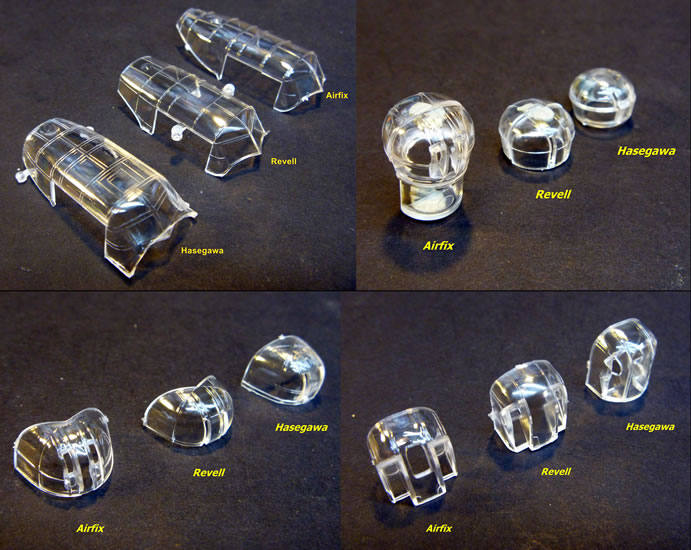
Dambusters flew without the mid-upper turret and its collar that served as a cam for the gun interrupters. Airfix supply the turret blanking plate fitted in its place. Also supplied are the bomb-bay faring fore and aft of the Upkeep Mine (the bouncing bomb) and its v-shaped trunnions. I could not help but notice that these are set at a different angle to the old Airfix Lancaster dambuster kit, and also to Hasegawa’s (no doubt to Revell’s too). I have seen a few diagrams, plans and detail sketches of the Upkeep mounting, but cannot attribute a degree of accuracy to any of them. Unfortunately, I have yet to see a clear period photo of the arrangement either. As a result I have no have no idea as to which kit is correct. Perhaps, given that Airfix have changed theirs from their earlier dambuster release, we can assume more accurate information has come to light than was available to them in 1980. Airfix also supply the hydraulic motor and chain drive used to spin the bomb, and of course the weapon itself. The chain is reasonably fine, but possibly just a tad thick compared to photos. Unlike the earlier Airfix dambuster, this one has a smooth casing without the wooden planking attached to some Upkeep mines. The spotlights used to fix altitude when flying low over water are also included. A nice addition with this kit is a bomb-trailer to carry the Upkeep mine. This appears to be well executed, with weighted tyres befitting its load.
The kit gives the impression that it will build well with few hassles; but bear in mind the warning about errors and omissions that others have already found in the instructions.
Colours & Markings
The colours and markings are the standard Bomber Command night heavy bomber scheme of dark green and dark earth disruptive camouflage over black sides and undersides.
The decals look very well registered and appear to have good opacity.
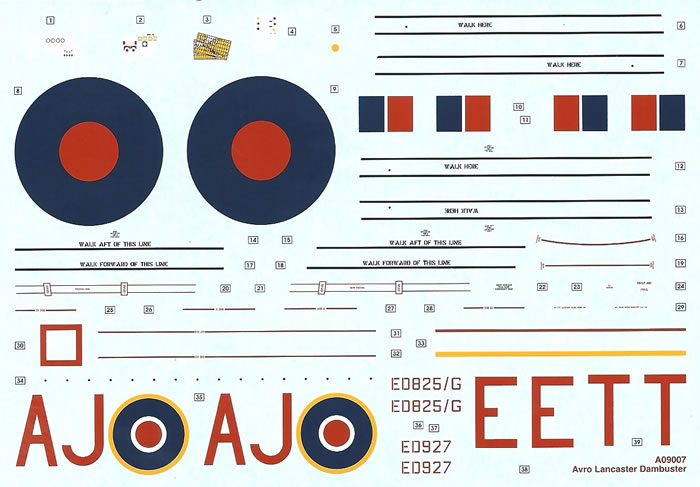
They include wing walk markings. Two aircraft are covered by the decal sheet, these being:
-
AJ-T piloted by Flight Lieutenant Joseph Charles McCarthy DFC (RCAF), No 617 Sqn, “Operation Chastise, RAF Scampton, England 16/17th May 1943.
-
AJ-T piloted by Flight Lieutenant Robert Norman George Barlow DFC (RAAF), No 617 Sqn, “Operation Chastise, RAF Scampton, England 16/17th May 1943. This aircraft and its crew were unfortunately lost in action on the Dams Raid.
A Comparison with the Competition
I briefly thought of including the 1981 Airfix tooling in this comparison, but chose not to as I no longer own one! Also, in the eyes of most, its natural challengers for best 1/72nd scale Lancaster are by Hasegawa & Revell. So it is these two brands that I shall now comment on regarding a quick and fairly arbitrary comparison with this new tool Lancaster by Airfix.
As I have already stated, Airfix do not yet equal Hasegawa or Revell in terms of recessed panel line finesse, but the surface detail of this new tool Lancaster is tolerable. On the plus-side, Airfix have fewer panel lines represented on the wings compared to the other two brands. Moulding quality is about equal across all three brands, with equal levels of finely moulded small parts. I like the texture of Airfix’s plastic more than the more brittle type used by the other two.
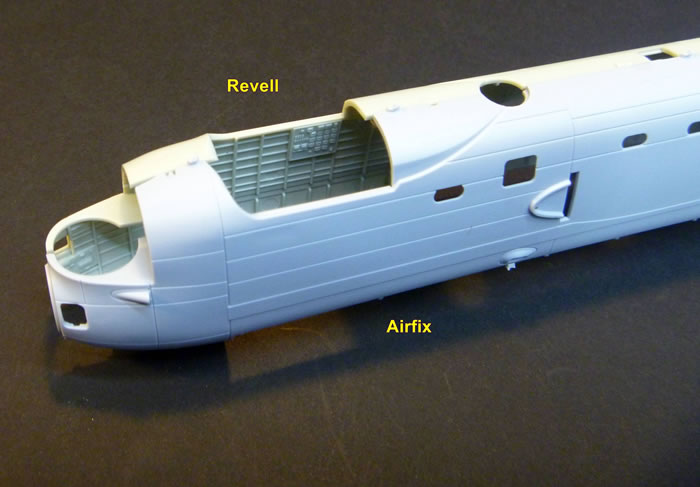
In terms of interior detail, cockpit, turrets, wheel wells, etc; Airfix and Revell are about equal, with Hasegawa well behind both. Both Airfix and Revell offer a dropped flap option, whereas Hasegawa does not. So far Revell has only offered a standard B.I/III and Dambuster option; whereas Hasegawa has covered these, Tallboy, Grand Slam, lifeboat carrier, and post war options. However, with a Mk.II already announced, Airfix looks set to sweep the field in due course.
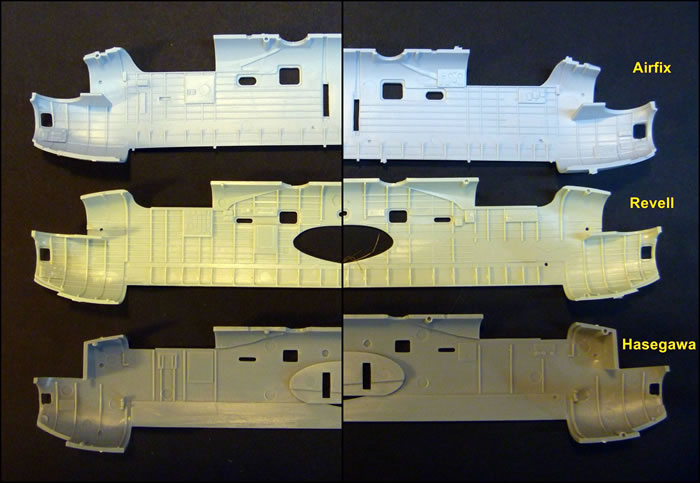
Looking at outlines and shapes it was clear that all three brands were in close agreement on the fuselage. I matched the Revell and Hasegawa fuselages to their Airfix opposite, aligning from where the bomb-aimer’s glazing attaches. Airfix and Revell did not quite agree on where the windscreen started, and Hasegawa differed a little in where the bomb-bay finished. Overall, Airfix was a little longer than Revell and a little shorter than Hasegawa. As mentioned earlier, Airfix’s small side windows are much larger than both the others, and I feel are incorrectly so. However this is easy to fix.
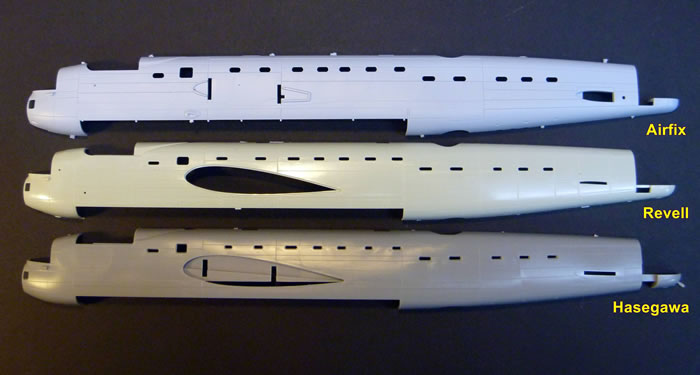
There is considerable variation in the mid-upper turret interrupter collar across all three brands. I think that Airfix is best and Revell worst overall here, but Hasegawa’s sharp aft taper is pretty bad too. Where they all fail is to have a wide enough and flat enough cam-track for the gun-interrupter followers to ride around. Photos of the real thing show this to be a distinct flat surface of an even width; as you would expect give that its surface is traced by followers traveling in a circle.
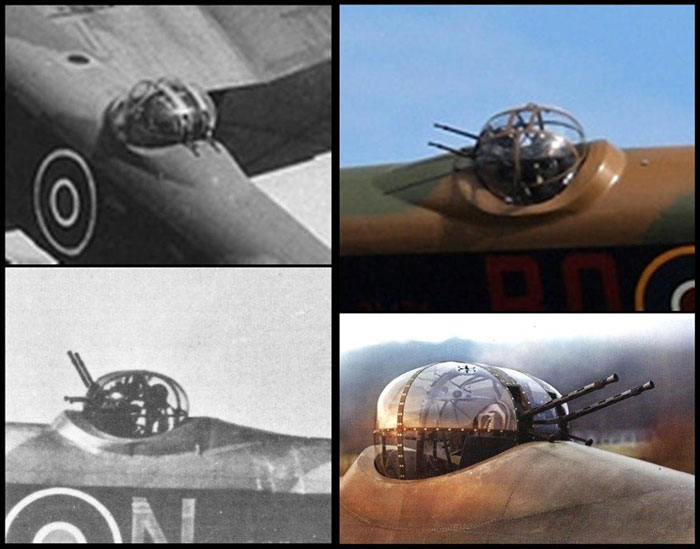

Lancaster wings are a pretty basic shape, so I was not expecting too much variation between brands. None agree exactly on the engine datums, and Airfix has its engines a bit wider out from the fuselage than the other two, not by miles, but there is a noticeable difference.

I used the inboard aileron edge as an alignment point because the three kits differ in the way they fit to the fuselage, with Hasegawa having extra length to insert inside the fuselage. I already knew that the Revell kit was lacking dihedral in outer wing sections, but I am now seriously beginning to wonder if Hasegawa has too much (the thought had previously crossed my mind when using Hasegawa’s wings for my York conversion). I placed all three wings on glass (which was covered with black card for photography purposes) with their flat horizontal inboard sections weighted down on the glass. I then measured the height of each wingtip above the glass, with these results:
-
7-mm for Revell,
-
14-mm for Airfix, and
-
20-mm for Hasegawa.
The accompanying images, especially the one featuring all three wings in line, highlight the difference. I am inclined to think that Airfix is probably the most correct here.
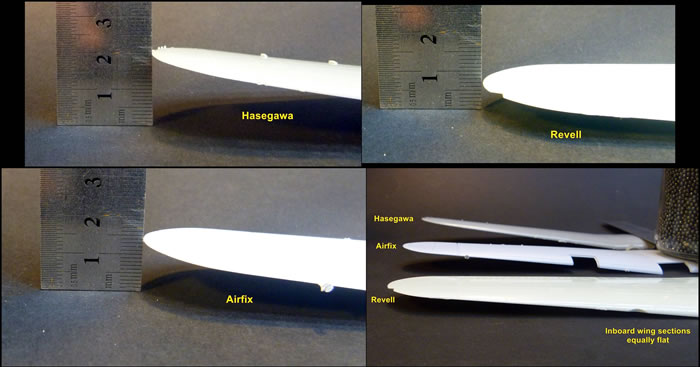
There is variation in the shape of engine nacelles, with Airfix and Hasegawa being closer to each other and Revell with their own interpretation. In fact I wonder if Revell was just practicing for the horrible Merlin engines on their Halifax kit when tooling their Lancaster, as their Lancaster too has over-sized and misshapen radiator mouths (but nowhere near as gross as the Halifax’s!).
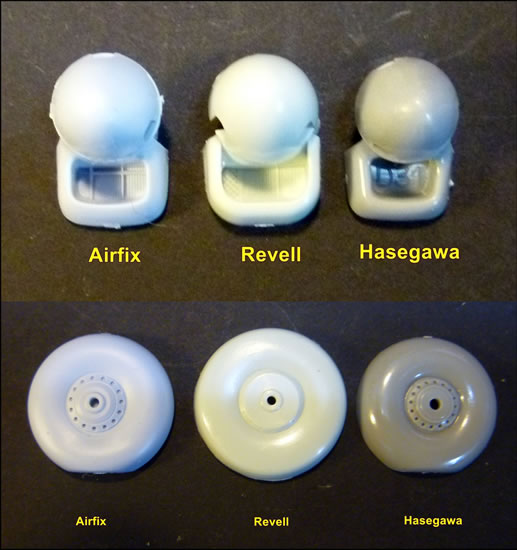
Rather than give lengthy written explanations, take a look at the accompanying images and it should be apparent as to why I feel Airfix are the winner in the engine nacelle stakes.
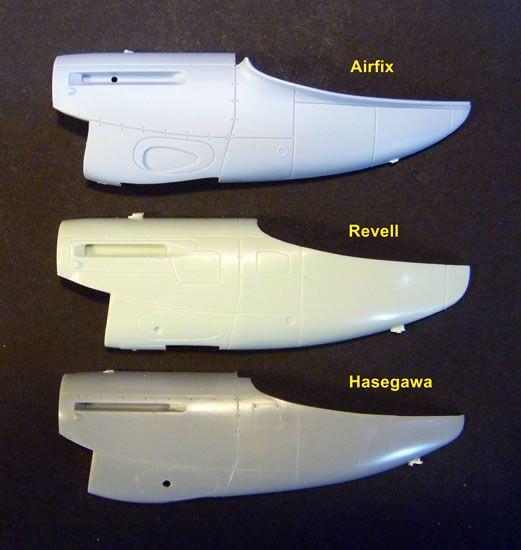
Airfix has I think the best shaped paddle blade props, and possibly the best pointed type too, although this latter type appears to be a bit narrow in chord; in which case Hasegawa could have the edge. Sorry to be vague on this point, but I could not make a firm call. However, Revell definitely comes third in the prop stakes.
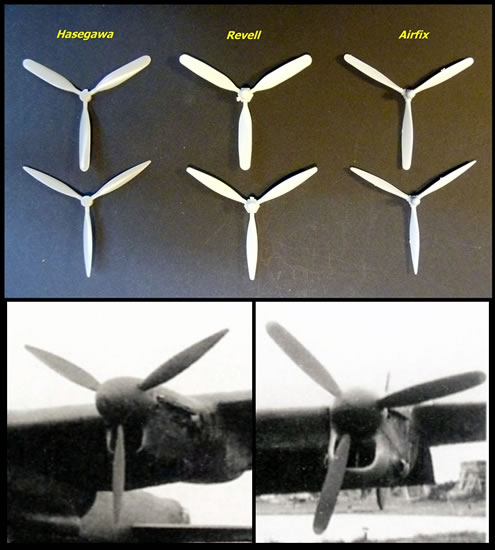
I found the main canopy hard to judge, other than to say Hasegawa’s is let down by thicker framing than the other two brands, and a misplaced escape hatch. There is some variation in turret sizes and shapes, with the closest agreement between all three for the rear FN20 (although Airfix has an open clear vision panel), and the most variation with the mid-upper FN50. I think Airfix has perhaps the best shape here, as Revell’s looks to be too large. The front turrets are similar, although and I think Airfix has the edge.
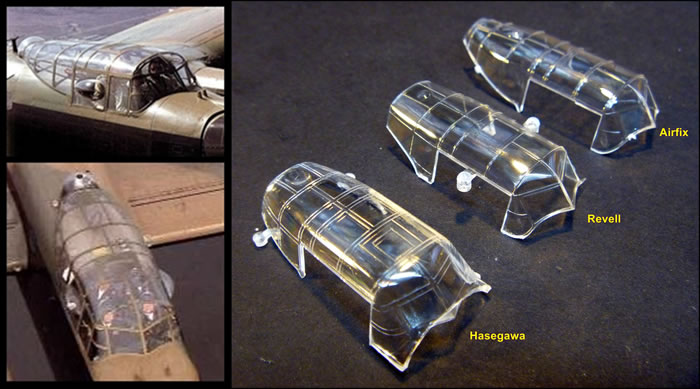
Airfix and Hasegawa main wheels look fine, whilst Revell’s are dreadful and over-sized.
The tail-planes have subtle differences in the angles of the leading a trailing edge. My images aligned with the fin mounting point and ensured the elevator hinge lines were parallel. It is apparent that Airfix overlooked giving the outboard edge of their elevators a chamfer to allow for rudder movement inboard (it is present on the real aircraft). Fortunately this is easy to fix with a simple cut. The tailfins and rudders are all very similar, with Airfix looking the best I think.

Unfortunately I did not have a copy of the new tool Revell Dambuster boxing to compare with the Airfix and Hasegawa Dambusters. However, Airfix and Hasegawa have quite different ideas about the Upkeep mine’s trunnions, and the “V” formed by Hasegawa’s trunnions has a more acute angle. Both depict the mine with a smooth casing, whereas I know from reviews that Revell’s mine has planking, as does the old tool Airfix Dambuster kit. Hasegawa’s Upkeep looks smaller than Airfix’s in the accompanying images, but this is in part because Hasegawa’s circular end-plates butt- fit the cylindrical body, and so adds to its width, whereas Airfix’s endplates fit into a rebate within the casing. The two brands generally agree on the dimensions of the bomb-bay fairings chain drive, although Hasegawa’s chain is much too thick.
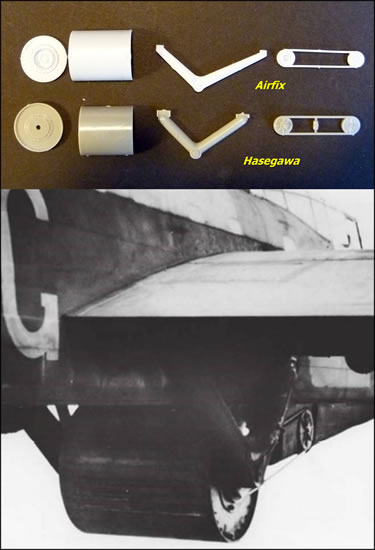
In my opinion, so not necessarily in fact:
-
Airfix beats Revell on accuracy and shape quite significantly in some areas (engines, wing dihedral, mid-upper turret fairing, and main-wheels), equals it on internal detail, and falls behind on panel line finesse.
-
Airfix beats Hasegawa on accuracy and shape but in small ways (engines, wing dihedral, mid-upper turret fairing, and canopies), beats it convincingly on internal detail, and falls behind on panel line finesse.
So there you have it.
I think that Airfix has the best lines, and equal best internal detail. Surface detail is a bit heavier than its rivals, but this is balanced by there being less of it.
There is big price range across the three brands, with Revell at one end, and Hasegawa at the other, whilst Airfix lies on the Revell side of the middle. Airfix is close enough in price to Revell to side with Airfix regardless of extra cost. I think therefore that the choice comes down to Airfix or Hasegawa - You can have a marginally better shape and internal detail, with less surface detail finesse, or more refined surface detail with marginally poorer shape (and either live with poorer internal detail or dress it up at a cost using after-market sets).
If you choose Hasegawa you have a lot more to spend, especially if you dress up the interior detail or replace the radiators.
For overall value, Airfix is the clear winner for me.
This is a sterling effort from Airfix (which reminds me, if only Airfix rather than Italeri were to release a new Stirling kit!). I consider this to be the best Lancaster kit so far released, with the promise of several versions including a long-awaited Mk.II.
Airfix have captured some key shapes better than their competitors, they have supplied plenty of nice interior detail, some of the best of which will hardly be seen in the wheel wells. Some parts are very finely moulded, and I like the plastic Airfix uses as it is nice to work with. The transparencies are very well done with delicate framing and very good clarity. The provision of a bomb-trolley for the Upkeep mine is a nice touch.
The kit has some way to go to approach perfection however. Airfix’s surfaces detail is acceptable; in part because the kit’s good points offset it. Looked at critically however, Airfix need to improve the finesse of their recessed panel detail to at least equal that which most other modern long-run brands have been offering for the past thirty years or more. I have a few niggles; oversized fuselage windows, no chamfer on elevator outer edge (both easily fixed), exaggerated fabric effect on ailerons, decaled rather than 3-D instrument panels, no parts map, and some proofing errors in the instructions.
As to its competitors from Revell and Hasegawa – You can save around 25-30% on Airfix and buy the less accurately shaped kit from Revell. The price of replacement resin wheels, which really are a must with the Revell kit, will reduce its price advantage however. For around 60-80% more than Airfix you can buy Hasegawa’s kit which offers only more refined panel lines and better props, but falls short on interior detail, no lowered flaps option, and inferior shape in a few subtle places. For my money then, Airfix is clear winner, and deservedly so.
I recommended this kit highly.
Airfix kits are available from hobby shops worldwide and online.
Review Text and Images Copyright © 2013 by Mark Davies
Page Created 19 June, 2013
Last updated
22 June, 2013
Back to HyperScale Main Page
Back to Reviews Page

|
